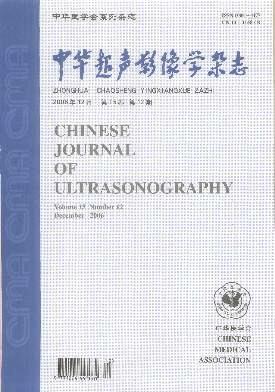The performance of ultrasound for differentiation of infantile fibrosarcoma and soft tissue hemangioma
Q4 Medicine
引用次数: 0
Abstract
Objective To investigate the differential performance of ultrasound between infantile fibrosarcoma(IFS) and soft tissue hemangioma. Methods The retrospective study was conducted from January 2012 to January 2019 in Beijing Children′s Hospital, Capital Medical University. A total of 16 patients with IFS were consecutively collected as IFS group, and 26 consecutive patients with soft tissue hemangioma (hemangioma group) were selected for comparison according to the tumor size of IFS. All the final diagnosis got confirmed by pathological analysis. The ultrasonographic features of IFS and hemangioma were compared and analyzed, and after weighting on the basis of the dominance ration (OR), the ultrasonic features with diagnostic value were used to establish the prediction equation. Then, the differential performance of every feature and the prediction equation was evaluated via the ROC analysis. Results There were differences in the lesion echo, margin and blood flow characteristics between IFS group and hemangioma group (P=0.013, 0.002, 0.005), the area under the ROC (AUC) of applying every ultrasonic feature with diagnostic value for differentiation were 0.695, 0.740, and 0.700, respectively. Benefiting from the employment of the prediction equation, the AUC was improved to 0.887 with a sensitivity of 81.3% and a specificity of 96.2%, which were better than the diagnosis by any single feature (P=0.017, 0.035, 0.003). Conclusions Ultrasound can be utilized to discriminate infantile fibrosarcoma from soft tissue hemangioma. The use of prediction equation can further improve the differential performance with higher clinical value. Key words: Ultrasonography; Infantile fibrosarcoma; Hemangioma; Children超声在婴幼儿纤维肉瘤与软组织血管瘤鉴别诊断中的应用
目的探讨婴儿纤维肉瘤(IFS)与软组织血管瘤的超声鉴别表现。方法对2012年1月至2019年1月在首都医科大学附属北京儿童医院进行回顾性研究。连续收集16例IFS患者作为IFS组,根据IFS的肿瘤大小,连续选择26例软组织血管瘤患者(血管瘤组)进行比较。最终诊断均经病理分析证实。比较分析IFS和血管瘤的超声特征,在优势比(OR)的基础上加权后,利用具有诊断价值的超声特征建立预测方程。然后,通过ROC分析对各特征和预测方程的差分性能进行评价。结果IFS组与血管瘤组在病变回声、边缘、血流特征上存在差异(P=0.013、0.002、0.005),各超声特征应用于诊断鉴别的ROC下面积(AUC)分别为0.695、0.740、0.700。利用预测方程,AUC提高到0.887,敏感性为81.3%,特异性为96.2%,优于单一特征的诊断(P=0.017, 0.035, 0.003)。结论超声可用于婴幼儿纤维肉瘤和软组织血管瘤的鉴别。预测方程的应用可以进一步提高鉴别性能,具有较高的临床价值。关键词:超声检查;小儿纤维肉瘤;血管瘤;孩子们
本文章由计算机程序翻译,如有差异,请以英文原文为准。
求助全文
约1分钟内获得全文
求助全文
来源期刊

中华超声影像学杂志
Medicine-Radiology, Nuclear Medicine and Imaging
CiteScore
0.80
自引率
0.00%
发文量
9126
期刊介绍:
 求助内容:
求助内容: 应助结果提醒方式:
应助结果提醒方式:


